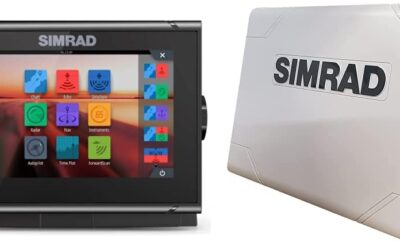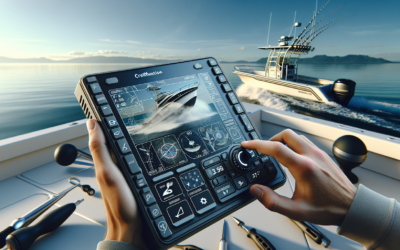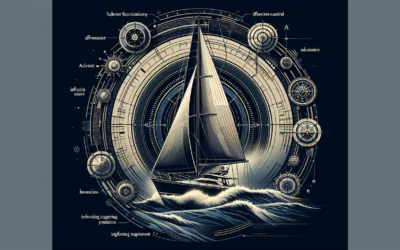You’re about to embark on an enlightening journey through the fascinating world of fish finders, specifically focusing on one particular element: noise rejection. This article enlightens on the incredible science behind how the silence, or noise rejection, plays a key role in the efficacy of these devices. It almost feels like deciphering a secret language as it helps you understand, why, in the world of fish finding, silence isn’t just golden, it’s absolutely crucial.
Understanding Fish Finders
When you embark on a fishing adventure, one considerable challenge can be locating the abundant fishing areas in the vast water body. That’s where a fish finder comes in handy. This device uses sonar sound waves to locate and display underwater information on your screen, offering you a ‘glimpse’ of what’s beneath your vessel.
Principle of operation
A fish finder operates using the principles of sound waves and their reflection. When you send a sound wave into the water, it travels downwards until it encounters an object or the bottom. The sound wave then rebounds or bounces back. The period it takes for the sound wave to return gives the finder an approximation of the depth and, depending on the strength of the signal, even the potential size of objects.
Components and their functions
Typically, a fish finder comprises of a display unit or screen, a transducer, and a power source. The transducer is what emits the sonar sound waves, converting electrical energy into sound energy and vice versa. The display unit showcases and interprets the data collected by the transducer, while the power source powers the entire set-up.
Types of fish finders
There are various types of fish finders available. The stand-alone type is excellent for small boats and novice users, primarily focusing on finding fish. Combo units combine the fish finder with a GPS chart plotter, enhancing navigation. Network models allow you to connect multiple devices, like radar, video, and satellite radio.
Noise in Fish Finders
As efficient as fish finders are, they aren’t without their challenges. One significant issue is noise, which interferes with fish finder readings and diminishes your device’s effectiveness.
Identifying noise in fish finder readings
Noise manifests as random lines, clutter, or fuzz on the fish finder screen. Its presence can cause misinterpretation of the data displayed, causing you to mistake noise for fish signals.
Factors contributing to noise
Various factors contribute to fish finder noise, including turbidity, device settings, water conditions, boat speed, and electrical interference from other devices. It’s crucial to understand these factors to reduce noise impacts.
Impacts of noise on fish finder efficiency
Noise can significantly affect the accuracy of your fish finder. It can lead to false readings, making it difficult to differentiate between fish and other underwater elements. Further, because fish finders rely on sound waves, excessive noise can distort these waves, reducing the sonar’s overall effectiveness.
Basics of Noise Rejection
Against the backdrop of noise creating mayhem to your ambitious fishing day out, fish finder manufacturers have devised a solution: noise rejection.
Defining noise rejection
Noise rejection refers to the fish finder’s ability to filter out unnecessary static, producing a cleaner, clearer image on the screen.
How noise rejection works in fish finders
Noise rejection works by discriminating against specific frequencies of the sonar return. By doing this, the fish finder adequately separates the noise (unwanted frequencies) from the actual signal (desired frequencies).
Importance of noise rejection
Noise rejection plays a crucial role in improving your fish finder’s performance and ensuring accurate results. It reduces the noise interferences, resulting in clear images that allow distinguishing between fish, structure, and the bottom.
Benefits of Noise Rejection in Fish Finders
Implementing noise rejection in your fish finding devices offers several significant benefits.
Accuracy enhancement
Firstly, noise rejection enhances the overall accuracy and clarity of the readings. By filtering out the noise, you get a cleaner, crisper image, allowing you to identify and differentiate underwater objects better.
Increased fish detection
Noise rejection increases fish detection. Since it removes all unnecessary clutter, it becomes much easier to spot and detect fish, thus increasing your chances of a successful catch.
Improved bottom tracking
Finally, noise rejection can significantly improve your device’s ability to track the bottom, even at high speeds. This enhancement helps maintain a constant, clear view of the seabed, essential for identifying structure or change in bottom composition.
Technologies Used in Noise Rejection
Manufacturers use various technologies to enhance noise rejection in fish finders. These include digital signal processing, use of filters, and interference rejection technology.
Digital signal processing
Digital signal processing is a technique that manipulates signals to enhance performance. It involves converting the analog signal into a digital one for more comfortable processing and then filtering the desired frequencies.
Use of filters
Filters help to reduce unwanted frequencies, thereby reducing noise and improving the fish finder’s image on the screen.
Interference rejection technology
Interference rejection technology targets external factors that contribute to noise. The devices are designed to minimize effects from sources like other sonars, electrical noises, and environmental elements.
In-depth Examination of Digital Signal Processing
Digital Signal Processing (DSP) plays a fundamental role in enhancing noise rejection and improving fish finder efficiency.
Understanding digital signal processing
Digital signal processing revolves around modification and manipulation of digital signals to optimize performance. It involves the conversion of analog signals to digital ones, which enables precise and faster processing.
Role of digital signal processing in noise rejection
In noise rejection, DSP plays an instrumental role. It helps to filter and differentiate between unnecessary (noise) and useful signals. This differentiation enables you to get a more uncluttered and clearer image on your display.
Influence of digital signal processing on fish finder efficiency
DSP substantially improves the efficiency of a fish finder by speeding up the data processing, leading to faster updates and real-time imaging.
Role of Filters in Noise Rejection
Filters are a critical component of noise rejection in fish finders. They assist in minimizing unwanted signals while preserving the desired ones.
Understanding filters in fish finders
In essence, filters are circuits or algorithms that segregate signals based on frequency. They can either permit or impede the passage of the signal, depending on the selected range of frequency.
Types of filters used
Different types of filters are used in fish finders. These include low-pass filters that allow frequencies below a certain range and high-pass filters that allow frequencies above a particular range.
How filters contribute to noise rejection
Filters work by eliminating unwanted frequencies that form ‘noise.’ This action contributes significantly to noise rejection, thereby improving signal clarity and enhancing the fish finder’s efficiency.
Understanding Interference Rejection Technology
Interference Rejection Technology (IRT) is another critical component in combating noise in fish finders.
The concept of interference rejection
Interference rejection is a function in fish finders designed to lessen the amount of noise or static on the screen caused by external factors. These external factors can include other sonar devices, natural surrounding elements, and even your boat’s electronics and motor.
Importance of interference rejection
Interference rejection is paramount for any angler as it reduces distortion, delivering a cleaner, clearer view of the underwater world. By minimizing this type of noise, you’re able to better identify fish, structures, and bottom contour.
Methods of executing interference rejection in fish finders
Manufacturers employ various techniques for executing interference rejection. These measures can include advanced algorithms, specialized filters, and hardware elements designed to separate genuine fish echoes from unwanted noise.
Selecting Fish Finders with Good Noise Rejection Systems
When decided on investing in a fish finder, make sure it includes a proficient noise rejection system.
Qualities to consider
You should consider qualities such as the type of noise rejection technologies being used, adjustability of noise rejection settings, and the fish finder’s ability to maintain performance in various water conditions and depths.
Popular brands with good noise rejection
Several brands specialize in fish finders with advanced noise rejection technologies, such as Garmin, Lowrance, and Humminbird. Their devices provide dependable noise rejection capacities, delivering cleaner, clearer underwater images.
Reading and understanding product specifications
To make the best purchasing decision, take time to read and understand product specifications. Look for information on DSP, interference rejection, and filter types. These specs will give you a clear idea of the fish finder’s noise rejection capabilities.
Maintenance and Care for Maximum Noise Rejection
Just like any other piece of equipment, fish finders require maintenance and care to remain functional and efficient.
Routine check-ups
Make routine check-ups on your device. Regularly inspect the transducer for any physical damage, as any defect can disrupt the sonar signals and induce noise.
Proper use and handling
Proper use and handling are paramount to ensuring your fish finder stays in top shape. Avoid misusing the device, and always follow the manufacturer’s instructions concerning usage to prolong the device’s lifespan.
Dealing with inevitable noise issues
Despite top-notch noise rejection features, sometimes you may experience noise issues due to inevitable factors like rough water conditions. Familiarize yourself with the corrective settings onboard your fish finder, like increasing the gain or adjusting the filter settings. This familiarity will help in maintaining efficient and productive fishing experiences.
In essence, understanding noise rejection in fish finders can significantly improve your fishing expeditions. With the reduction of noise, it becomes easier to detect fish, track the bottom, and navigate waters. So remember, when you choose your next fish finder, make sure it includes an effective noise rejection system. Happy fishing!









